
Nembrotha lineolata
Bergh, 1905.
Order: NUDIBRANCHIA
Suborder: DORIDINA
Family: Polyceridae
Subfamily: Nembrothinae
DISTRIBUTION
Tropical Pacific Ocean and reported on the Forum [#16685 ] from the western Indian Ocean.
PHOTO
Lizard Id., Great Barrier Reef, Queensland, November 1981. Photo: Bill Rudman.
Gosliner, Behrens & Williams (1997) report it feeding on the ascidians Clavelina spp., Rhopalaea sp., & Oxycorynia fascicularis.
See also Nembrotha sp. 13.
Reference:
• Gosliner, T.M., Behrens, D.W. & Williams, G.C. (1997) Coral Reef Animals of the Indo-Pacific. 314pp. Monterey, California: Sea Challengers.
Rudman, W.B., 1998 (April 22) Nembrotha lineolata Bergh, 1905.. [In] Sea Slug Forum. Australian Museum, Sydney. Available from http://www.seaslugforum.net/find/nemblin
Related messages
Nembrotha lineolata from sthn Queensland
October 14, 2008
From: Gary Cobb
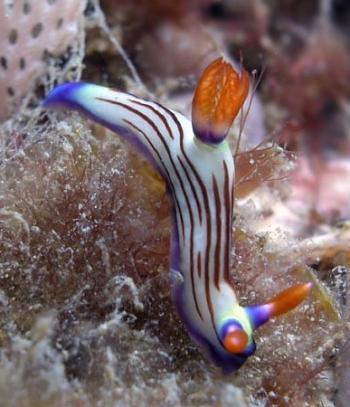
Hi Bill and everyone!
Here is an entry for Nembrotha lineolata from sthn Queensland. It was found after descending to the bottom, adjusting cameras, to the rocky ledge and there it was! It appears to be another record for sthrn Queensland according to Richard Willan.
Locality: Old Woman Island, Mooloolaba, Sunshine Coast, 12 m, Queensland, Australia, Pacific Ocean, 04 October 2008, Subtidal. Length: 15 mm. Photographer: Gary Cobb and David Mullins.
Cheers
Gary
gary@nudibranch.com.au
Cobb, G.C., 2008 (Oct 14) Nembrotha lineolata from sthn Queensland. [Message in] Sea Slug Forum. Australian Museum, Sydney. Available from http://www.seaslugforum.net/find/21942
Thanks Gary,
Bill Rudman
Re: Nembrotha rutilans mating
August 8, 2008
From: Tamara Hartwich

Concerning message #13711:
Dear Bill,
I took this photo of mating nudis in the Russell Islands in Solomon Islands. They were hanging upside down on a wall at about 18 metres.
We are uncertain as to whether these are Nembrotha lineolata or Nembrotha rutilans. Could you please assist in identifying them?
Locality: Lologhan, 18 metres, Russell Islands, Solomon Islands, West Pacific Ocean, 27 July 2008, Reef wall with strong currents. Length: 2 to 3 cm. Photographer: Tamara Hartwich.
Thanks
Tamara Hartwich
tamhartwich@yahoo.com.au
Hartwich, T.M., 2008 (Aug 8) Re: Nembrotha rutilans mating. [Message in] Sea Slug Forum. Australian Museum, Sydney. Available from http://www.seaslugforum.net/find/21773Dear Tamara,
As I say in an earlier message [#21249], the distinction between some of these species is a bit unclear, but if they are distinct I would consider this colour form to be N. lineolata. Nembrotha rutilans is now considered a synonym of N. purpureolineata.
Best wishes,
Bill Rudman
Sex in East Timor
April 28, 2008
From: Brian Francisco
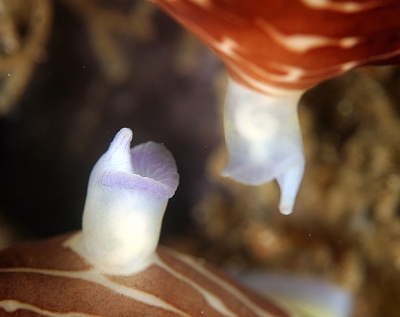
Hi Bill
This photo needs little explanation. Just thought it was a cool shot of Nembrotha sex organs. It took the two about 15 seconds to connect.
Locality: Bob's Rock, 16 meters, East Timor, Banda Sea, 5 August 2007, coral wall. Length: 2.5 cm. Photographer: Brian Francisco.
Brian
www.uwet.net
francisco.brian@gmail.com
Francisco, B., 2008 (Apr 28) Sex in East Timor. [Message in] Sea Slug Forum. Australian Museum, Sydney. Available from http://www.seaslugforum.net/find/20525Thanks Brian,
Your message highlights an interesting point. I am not sure from your photo if you animals are a form of Nembrotha lineolata with thick colour bands [see message #19904] or are a form of Nembrotha purpureolineata. The external reproductive organs of both species are very similar in shape [see message #13711]. I won't go as far as suggesting that both species may be colour forms of one species, but both seem to have a great range in colour variability.
Perhaps you could put me out of my misery and send me a photo of the whole of one of these animals?
Best wishes,
Bill Rudman
Re: Nembrotha lineolata - feeding observations
April 15, 2008
From: Richard Swann
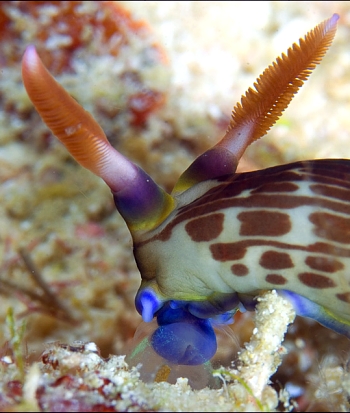
Concerning message #16176:
Hi Bill
I hope you find a few additional shots similar to Brian's of Nembrotha lineolata feeding to be of interest.
Locality: Kapalai island, 10-14 meters, Sabah, Borneo, Celebes Sea, 22nd March 2008, sheltered reef. Length: 3-4 cm. Photographer: Richard Swann.
Kind regards
Richard
www.downbelow.co.uk
richard@downbelow.co.uk
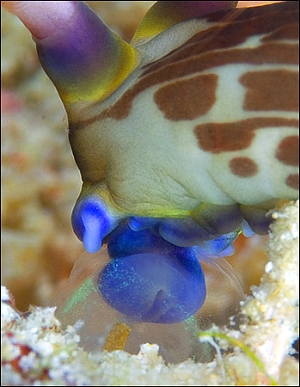
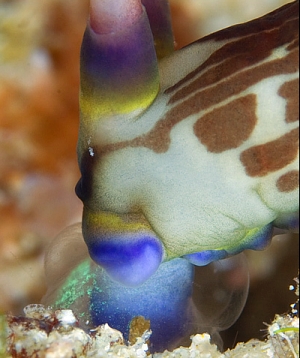
Thanks Richard,
I am always interested in 'additional shots'. The first observation of an animal 'doing something' is always of great interest - and the original observer deserves praise, but the third, fourth ... and subsequent observations are also very important because they show that this behaviour is part of the animal's way of life and not just a strange aberration.
Best wishes,
Bill Rudman
Is this Nembrotha rutilans ?
February 15, 2008
From: Aaron Fink

Bill:
I saw this nudibranch in Palua at arounnd 40 ft depth on a reef top. I was wondering if this is Nembrotha rutilans?
Locality: Barnum's Wall, 40 ft, Palau, Pacific Ocean, 03 September 2007, reef. Length: 3 inches. Photographer: Aaron Fink.
Thanks
Aaron
afink01@comcast.net
Fink, A.S., 2008 (Feb 15) Is this Nembrotha rutilans ?. [Message in] Sea Slug Forum. Australian Museum, Sydney. Available from http://www.seaslugforum.net/find/21249Dear Aaron,
There are a group of species all with quite similar colour patterns, and when you look at the messages attached to each species' Fact Sheet it seems possible that I have either misidentified a few animals or demonstrated how difficult it is to separate some colour 'forms'. The species areNembrotha lineolata , Nembrotha purpureolineata, Nembrotha rutilans and Nembrotha megalocera. If they are all different, I suspect from the colour of the rhinophores and the rhinophore sheaths that this is a form of N. lineolata.
Best wishes,
Bill Rudman
Nembrotha lineolata - finding mating partners?
July 13, 2007
From: Carlos R. Munda

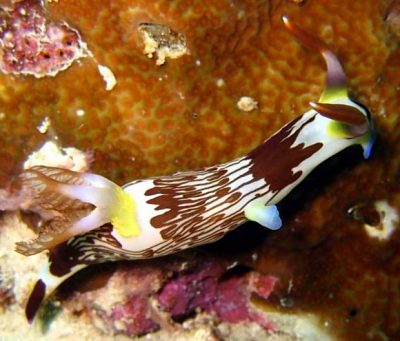
Here are a couple of mating nembrothas (N. lineolata?). I first observed the specimen in the middle photo about a foot from the other one. I first noticed the strange protrusion on its side and wondered if it was some kind of injury.
When it had worked its way to the other nembrotha, I noticed the same appendage starting to grow from the second specimen and thats when i figured what was about to happen...
What i can't figure out is how the first specimen knew that other one was there. I figure the way the current was moving had something to do with it. but if that was the case, how did the second Nembrotha know when to stick its own organ out just when its mate was getting near - but not yet near enough to touch.
Locality: Samal island, Davao gulf, 40-50ft, Philippines, pacific, 23 December 2006, wall, reef face. Length: 2-3 inches. Photographer: Carlos R. Munda, jr..
Carlos R. Munda
c_munda@yahoo.com
Munda, C, 2007 (Jul 13) Nembrotha lineolata - finding mating partners?. [Message in] Sea Slug Forum. Australian Museum, Sydney. Available from http://www.seaslugforum.net/find/19082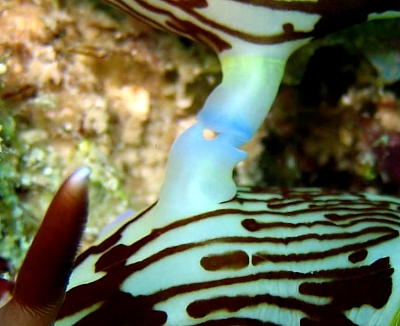
Dear Carlos,
Yes these are N. lineolata. Smell and touch are the only 'senses' these animals have. They can't talk to each other or see each other, so any communication must be through scent or touch. Clearly from their ability to find their food, their sense of smell is very well developed. Although there have been many experiments to show how nudibranchs find their food by smell, I don't know of any that have been designed to study just how well they can sense potential partners. You may remember a message I posted last year [#17419 ] about the Sea hare 'love drug' which seems to serve this function.
Best wishes,
Bill Rudman
Mating pair of Nembrotha lineolata
May 25, 2007
From: Carrie Lo
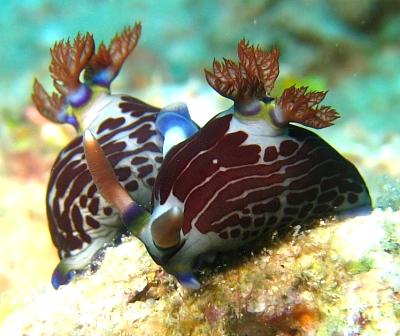
Hi Bill,
I found this pair of Nudis in Derawan, in the Berau Archipelago (East-Kalimantan, Borneo, Indonesia). Could you please help identifying this?
Locality: Site: Coral Canyon, 15m, Indonesia, 22 April 2007. Length: 1 inch. Photographer: Carrie Lo.
Thanks,
Carrie
carrielohc@yahoo.com.hk
Lo, C., 2007 (May 25) Mating pair of Nembrotha lineolata. [Message in] Sea Slug Forum. Australian Museum, Sydney. Available from http://www.seaslugforum.net/find/19904Dear Carrie,
This is a mating pair of Nembrotha lineolata. The brown lines are usually much thinner than in these animals, but it could be because they are partially contracted
Best wishes,
Bill Rudman
Re: Nembrotha lineolata from Tanzania
May 31, 2006
From: Wilhelm van Zyl
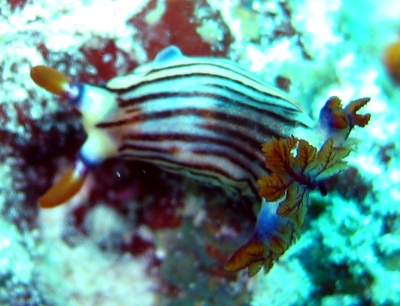
Concerning message #16685:
Hi Bill,
I found this specimen on a dive around Nungwi on Zanzibar Island. Zanzibar is of course part of Tanzania and it is there for another example of Nembrotha lineolata in the western Indian Ocean.
Locality: Nungwi, 12 m, Zanzibar, Indian Ocean, 29 November 2005, Coral Reef. Length: 2 cm. Photographer: Wilhelm van Zyl.
Regards
Wilhelm
diving@cyberdale.co.za
Van Zyl, F.W., 2006 (May 31) Re: Nembrotha lineolata from Tanzania. [Message in] Sea Slug Forum. Australian Museum, Sydney. Available from http://www.seaslugforum.net/find/16726Thanks Wilhelm,
Another animal with the 'typical' colour pattern is a useful addition to our knowledge. I have many happy memories of working in Zanzibar in the early 1970s, so I am a little jealous of your trips to that wonderful place.
Best wishes,
Bill Rudman
Nembrotha lineolata from Tanzania
May 29, 2006
From: Claus Gregersen

Hi Bill
After having browsed through all your colour varations of Nembrotha lineolata I'm pretty sure that the attached photo shows one as well.
However, the photo was taken in the south of Tanzania so perhaps distribution could be expanded a bit (if you agree to the id, of course)?
Locality: Dive site Mini Monos in Mikindani Bay, 14 metres, Tanzania, Indian Ocean, 16 November 2005, Coral patches and rubble. Length: ??. Photographer: Lene Kim Slengerich.
Best regards
Claus Gregersen
e-mail@kofte.dk
Claus Gregersen, 2006 (May 29) Nembrotha lineolata from Tanzania. [Message in] Sea Slug Forum. Australian Museum, Sydney. Available from http://www.seaslugforum.net/find/16685Dear Claus,
This is a very interesting find. Your animal does indeed look as though it is Nembrotha lineolata which, to my knowledge has only been reported from the Pacific Ocean and Indonesian Archipelago. I have wondered the Indian Ocean N. purpureolineata was a geographic colour form of N. lineolata, but your specimen from as far west in the Indian Ocean as you can go, would suggest that they are probably different.
It is an exciting find
Best wishes,
Bill Rudman
Nembrotha lineolata - feeding observations
March 28, 2006
From: Brian Francisco
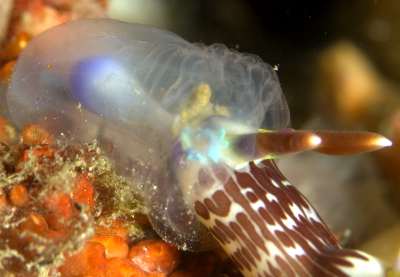
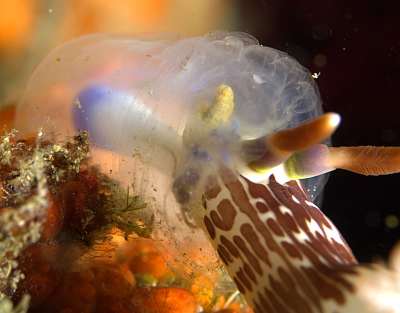
Hi Bill
Here are few shots of Nembrotha lineolata feeding.
Locality: K-41, 13 meters, East Timor, Banda Sea, 25 March 2006, Coral Reef. Length: 4 cm. Photographer: Brian Francisco.
Brian
francisco.brian@mail.com
Francisco, B., 2006 (Mar 28) Nembrotha lineolata - feeding observations. [Message in] Sea Slug Forum. Australian Museum, Sydney. Available from http://www.seaslugforum.net/find/16176
Dear Brian,
Not many days go by on the Forum between exciting new observations. The way your animal extends its oral tube right into the test of the ascidian to eat out the fleshy part of the animal is almost identical to the Atkinson's photos of N. rutilans feeding [message #15797]. Solitary ascidians like this, often know as 'sea squirts', have a outer sac which protects the delicate sieve like basket which filters their food out of the sea water and encloses the rest of the body. It looks like species of Nembrotha feed on solitary ascidians by inserting their extensible oral tube through one of the siphons to get to the fleshier parts of the body.
Best wishes,
Bill Rudman
Nembrotha lineolata from Sulawesi
February 15, 2006
From: Bob Whorton
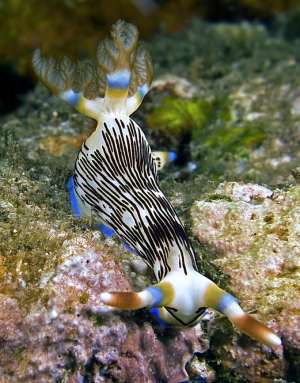
Hi Bill,
Here are a few shots of Nembrotha lineolata.
Very active slug, found looking for food outside Wori Bay, North of Manado, northern Sulawesi. Indonesia. Depth: 8 M . Length: 3 inches. Early May 2005. Photographer: Bob Whorton
Very cute face on this species.
Bob Whorton
drbob.whorton@btinternet.com
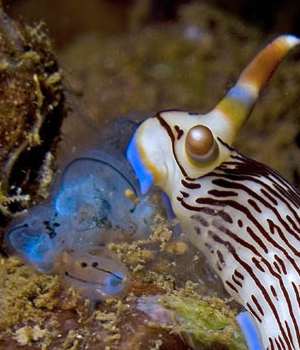
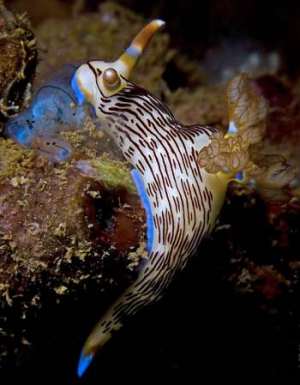

Dear Bob,
It's good to get good photos of it feeding. And the photos of its colour pattern are helpful in building up our understanding of colour variability in this species.
Best wishes,
Bill Rudman
Nembrotha lineolata from west Malaysia
September 12, 2005
From: Ho Wei Kwok Alvin
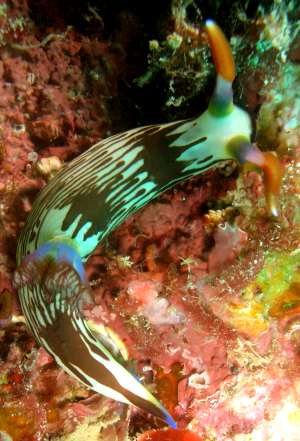
Hi Bill,
Found a nice specimen of Nembrotha lineolata while diving at Pulau Dayang. This was a dive at a site called Jawa.
Locality: Pulau Dayang, west Malaysia, South China Sea. Depth: 15 m, Length: 50 mm. 6 Aug 2005. Sandy/Coral Reef, Photographer: Alvin Ho
Regards,
Alvin
howeikwok@hotmail.com
Ho, W.K.A., 2005 (Sep 12) Nembrotha lineolata from west Malaysia. [Message in] Sea Slug Forum. Australian Museum, Sydney. Available from http://www.seaslugforum.net/find/14679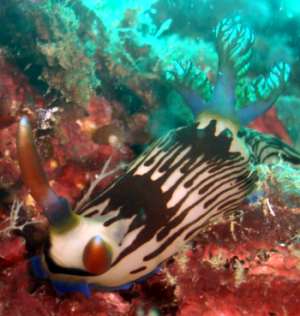
Thanks Alvin,
Thsi one shows how the longitunal lines merge to form the tranverse bands found in some colour forms of this species.
Best wishes,
Bill Rudman
Re: Nembrotha lineolata with transverse lines
August 2, 2005
From: David Bush
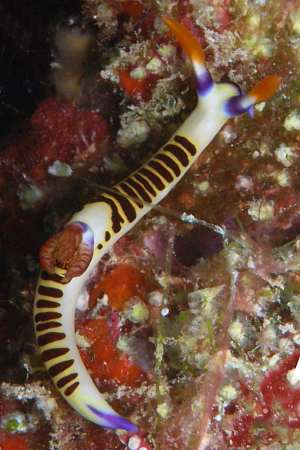
Bill,
Concerning my earlier message [#14060]. I contacted the liveaboard company (Mike Ball Dive Expeditions based in Cairns). They gave me the following coordinates for "Two Up" reef:
Coral Sea, Flinders Reef, Lat: 17 41 471, Long: 148 30 479
It is basically two large Bommies sitting next to each other, thus the name. It is a common site for the Spoilsport (dive boat), so if you want more details, you could contact MBDE. I'm sending along two more pictures.
Thanks for you help, let me know if you learn anything more about this variety...
Dave Bush
Titusville, Florida
dbush@cfl.rr.com
Bush, D., 2005 (Aug 2) Re: Nembrotha lineolata with transverse lines. [Message in] Sea Slug Forum. Australian Museum, Sydney. Available from http://www.seaslugforum.net/find/14449
Dear Dave,
Thanks for the information. The Great Barrier Reef is so large and I am never sure whether names like "Two Up" Reef are local names or 'official' names. I guess the name "Two Up" also refers to an old Australian gambling game where two coins are thrown in the air and you bet on whether they both will come up the same way.
Concerning the nudibranch. If I hadn't seen the intermediate forms I would say this was a distinct species.
Best wishes,
Bill Rudman
Nembrotha lineolata with transverse lines
June 15, 2005
From: David R. Bush
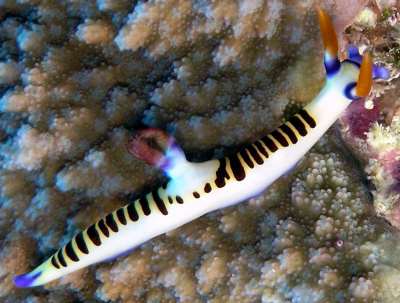
Hello,
I found this Nudibranch and so far haven't been able to find anything identifying it. Thought perhaps it might be new. It is very similar to the "Lined Nembrotha" with the exception that the lines run transverse to it's body rather than parallel. Let me know if possible.
Locality: SuperSport Liveaboard, "Two Up" Reef, Queensland, Australia.
Depth: 30-60 feet. Length: 2-3 inches. 27 May 2005. Photographer: David R. Bush
I have a few more photos if you are interested.
Thanks,
David Bush
Titusville, Florida
dbush@cfl.rr.com
Bush, D.R., 2005 (Jun 15) Nembrotha lineolata with transverse lines. [Message in] Sea Slug Forum. Australian Museum, Sydney. Available from http://www.seaslugforum.net/find/14060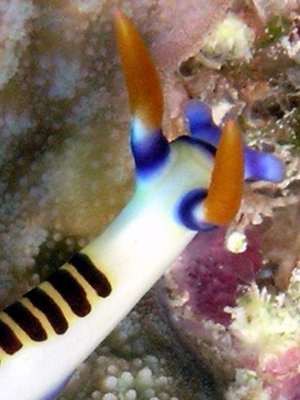
Dear Dave,
This is the second time I have seen a photo of this colour form [see message #2894]. As I discuss in that message I am pretty sure it is a strange colour variety of Nembrotha lineolata. Can you give me a bit more information on where in Queensland 'Two Up Reef' is please?
Best wishes,
Bill Rudman
Nembrotha lineolata from Fiji
June 14, 2003
From: David & Leanne Atkinson
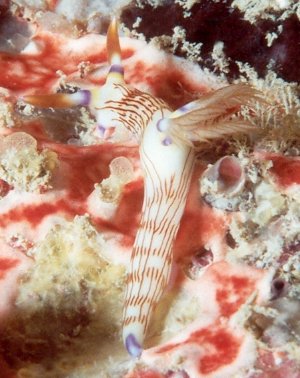
Dear Bill,
After reading Vasa's message about Nembrotha lineolata we checked out the rest of the messages on this species and noticed you didn't have one from Fiji. We photographed this tiny one as follows:
Location: Plantation Pinnacle, near Malolo Lai Lai, Fiji.
Date: 4/2001, daytime
Size: about 5mm,
Water Temperature: 30 degrees c.
Yours sincerely,
David and Leanne Atkinson
atk@hunterlink.net.au
Atkinson, L. & D., 2003 (Jun 14) Nembrotha lineolata from Fiji. [Message in] Sea Slug Forum. Australian Museum, Sydney. Available from http://www.seaslugforum.net/find/10194Thanks David & Leanne,
Bill Rudman
Nembrotha lineolata - reproduction
June 10, 2003
From: Vasa P. Sirinupongs

Hi,
I am sending you photos of Nembrotha lineolata mating and laying eggs. I hope they can be useful for your web. Photos were taken by myself during dives at Dumaguete, Philippines on 3 May 2003. I find quite a number of this species around this area.
Vasa
photo@scubadiving.com

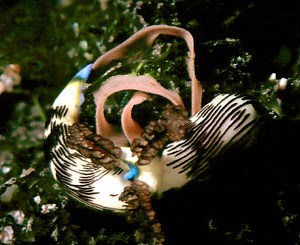
Thanks Vasa,
Bill Rudman
Nembrotha lineolata from Borneo
January 27, 2003
From: Mark Burnett
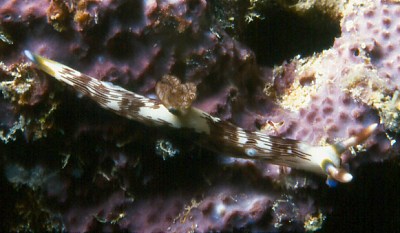
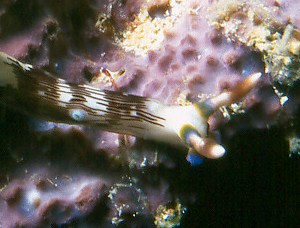
Hi Bill,
Here is another of my slides from Mabul, Borneo. This is, and please correct me if I'm wrong, Nembrotha lineolata. Interestingly, as with N. rutilans, this particular specimen has blue oral lappets. All my pictures were taken with a Nikonos V, Ikelite extension tubes and framers (mainly 1:2) and an Ikelite Substrobe 150 using Fuji Velvia.
Mark Burnett
mburnett@actrix.gen.nz
Burnett, M., 2003 (Jan 27) Nembrotha lineolata from Borneo. [Message in] Sea Slug Forum. Australian Museum, Sydney. Available from http://www.seaslugforum.net/find/8803Thanks Mark,
I am not sure if the colour of the oral lappets is important. Its just useful to build up information like this. Hopefully a pattern will emerge.
Cheers,
Bill Rudman
Nembrotha lineolata from North Sulawesi
January 21, 2003
From: Alice Lee
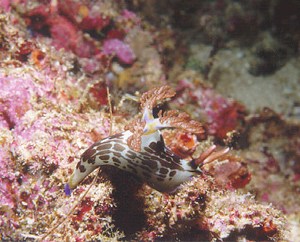
This nudibranch was taken at Tanjong Pisok, North Sulawesi, Indonesia at the depth of 15m on 31 January 2002. Could not find an identity for it, can you please help to identify it.
Thanks.
Regards,
Alice
alee@dlink.com.sg
Lee, A., 2003 (Jan 21) Nembrotha lineolata from North Sulawesi. [Message in] Sea Slug Forum. Australian Museum, Sydney. Available from http://www.seaslugforum.net/find/8927Dear Alice,
This is a colour form of Nembrotha lineolata.
Best wishes,
Bill Rudman
Nembrotha lineolata from nthn Sulawesi
July 9, 2002
From: Helmut Schirmböck

Here is another picture for your site. It was taken in the Bunaken Is - Lembeh Strait region of Nth Sulawesi, Indonesia, [April-May, 2002] but I don't know the diveplaces anymore.
Sorry.
Regards,
Helmut.
schirmis@aon.at
Schirmböck, H. , 2002 (Jul 9) Nembrotha lineolata from nthn Sulawesi. [Message in] Sea Slug Forum. Australian Museum, Sydney. Available from http://www.seaslugforum.net/find/7407Dear Helmut,
It is interesting to see this animal, Nembrotha lineolata on the ascidian Polycarpa aurata. In Mary Jane Adams' recent message she asked whether it was significant that she had found this animal laying its eggs on this ascidian. While in itself, we couldn't draw any significance from the observation, a second observation of the species in association with this ascidian certainly suggests we should keep our eyes out for more evidence that Nembrotha lineolata feeds on it. Looking at the colour of the ascidian in your photo, the blue and yellow and the lines, are all repeated in the colour pattern of the nudibranch. I had never thought of its colour pattern being a camouflage pattern, but again its something worth thinking about. As noted on the Fact Sheet, this species is reported to feed on a number of different ascidians, none of which have any colour similarities.
Best wishes,
Bill Rudman
Nembrotha lineolata laying eggs
May 22, 2002
From: Mary Jane Adams
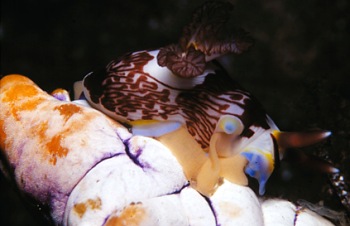
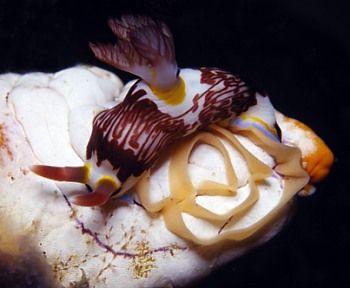
Hi Bill,
Here are two views of Nembrotha lineolata laying eggs. Do you think it is significant that this ascidian-eating slug has chosen to deposit it's eggs on the solitary tunicate, Polycarpa aurata? In the side view I can see how the foot plays a role in pressing the egg ribbon onto the substrate. Divesite: Batu Sandar, Lembeh Strait, Sulawesi, Indonesia
Best regards,
Mary Jane
divepng@yahoo.com
Adams, M J., 2002 (May 22) Nembrotha lineolata laying eggs. [Message in] Sea Slug Forum. Australian Museum, Sydney. Available from http://www.seaslugforum.net/find/6854Thanks Mary Jane,
It's probably not significant that it is laying its eggs on the large solitary ascidian, although I suppose it is possible that it eats this ascidian as well as the smaller ones. Many nudibranchs, and other opisthobranchs, such as the sacoglossans, lay their eggs on their food, primarily because the adult lives on its food. This really only has value to the next generation in species with an abbreviated developmental cycle, especially in those in which the hatchlings are minute slugs which crawl out of the egg mass straight on to their preferred food. From Jim Anderson's photos of the egg ribbon, I am pretty sure that N. lineolata has planktotrophic veliger larvae, so where the egg ribbon is laid is probably unimportant.
Best wishes,
Bill Rudman
Nembrotha lineolata from the Solomons
September 14, 2001
From: Bruce Potter
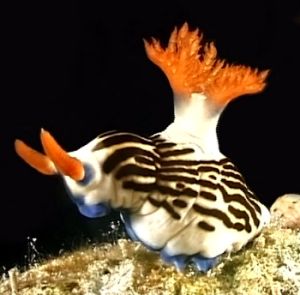
Dear Bill,
I saw this Nembrotha lineolata on a night dive last weekend. It was posing so nicely, that I thought you might be interested in it.
It was at about 3 meters, on a coral and rubble site called the "Wreck of the Anne". this is in the Russell islands, part of Solomon Islands.
Regards
Bruce Potter.
bruce.potter@adventist.org.sb
Potter, B., 2001 (Sep 14) Nembrotha lineolata from the Solomons. [Message in] Sea Slug Forum. Australian Museum, Sydney. Available from http://www.seaslugforum.net/find/5255Dear Bruce,
Ther's always room on the Forum for a nice pose. With this Nembrotha lineolata every photo helps to sort out the colour patterns.
Best wishes,
Bill Rudman
Nembrotha lineolata with spawn
July 5, 2001
From: Jim Anderson

Dear Dr. Rudman,
The enclosed was photographed at 'Angels Window' dive site on Lembeh, N. Sulawesi, Indonesia on 18 June 01 at a depth of 23 metres. It was approx 70mm long.
Kind regards,
Jim A
jander4454@aol.com
Anderson, J., 2001 (Jul 5) Nembrotha lineolata with spawn. [Message in] Sea Slug Forum. Australian Museum, Sydney. Available from http://www.seaslugforum.net/find/4740
Dear Jim,
Thanks for the beautiful, and interesting photo. I've included an enlarged view of some of the ribbon to show the tiny yellow eggs, suggesting that this species has free-swimming veliger larvae which feed in the plankton (planktotrophic).
When I first saw the photo I thought we had no evidence that this was the egg ribbon of Nembrotha lineolata. I could see an inner and an outer end to the ribbon suggesting that Nembrotha could just be crawling past. But then I noticed that just below the posterior tip of the tail there is a third end suggesting that this animal has just started to lay a second ribbon within the coils of the existing ribbon. Very unusual, but at least it identifies the egg ribbon as that of N. lineolata.
Best wishes,
Bill Rudman
Nembrotha lineolata feeding
August 22, 2000
From: Erwin Koehler

Dear Bill,
Here is a Nembrotha lineolata from the Philippines feeding on the same ascidian as Nembrotha chamberlaini does.
Size 4 cm, depth 9 m,
Nov. 01, 1998,
Panglao Island, divesite "Bohol Beach Club -BBC)"
Erwin
Medslugs.Koehler@t-online.de
Koehler, E., 2000 (Aug 22) Nembrotha lineolata feeding. [Message in] Sea Slug Forum. Australian Museum, Sydney. Available from http://www.seaslugforum.net/find/2906Dear Erwin,
Thanks for the wonderful photo.
Bill Rudman.
Transverse lines on Nembrotha lineolata
August 17, 2000
From: Dirk Hasberg
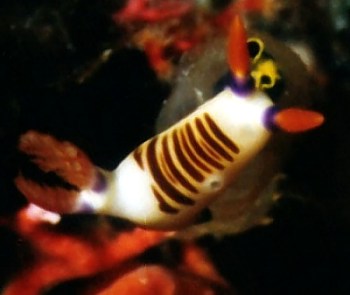
Bill,
I found this species while diving off Townsville, Queensland, Australia [Flinders Reef, Coral Sea] earlier this year. I've tried to identify it but to no avail.
Thought it might be worth sending a photo in to you for identification. I'd never seen a nudibranch with markings perpendicular to the body before this one.
Regards,
Dirk Hasberg
909918N@knotes.kodak.com
Hasberg, D., 2000 (Aug 17) Transverse lines on Nembrotha lineolata. [Message in] Sea Slug Forum. Australian Museum, Sydney. Available from http://www.seaslugforum.net/find/2894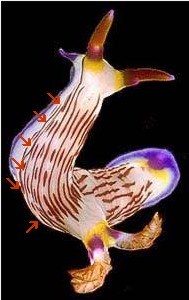
Dear Dirk,
I must say it's the first time I have seen one like this also. With the proviso that I would need to look at its anatomy to be 100% sure, my feeling is that this is a very strange colour form of Nembrotha lineolata. If so, it must have faced west instead of north when the stripes were being applied!
While it is amazing how scientists can now delve into the makeup of the human genome, we are still a long way from really knowing how genes translate into things like colour patterns. If you look at the photo I have posted alongside of a fairly typical N. lineolata you will see I have added arrows alongside zones where there are transverse bands of extra longitudinal brown lines. It is possible that some short-circuit in the message from the genes during development, or some mutation in the genes themselves has made the transverse band dominant in your animal.
It is indeed fascinating. All other features of the colour pattern match typical N. lineolata, although the yellow at the base of the rhinophores and gills in your animal is rather faint.
If you have any other interesting photos, they would be very welcome on the Forum.
Best wishes,
Bill Rudman.
Nembrotha lineolata from Papua New Guinea
August 9, 2000
From: Mary Jane Adams
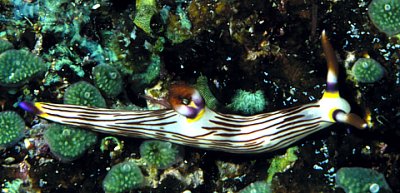
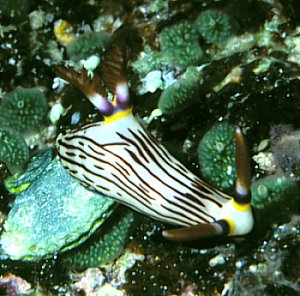
Hi Bill,
Here are some images of Nembrotha lineolata from Eastern Fields, a coral reef 170 km southwest of Port Moresby, Papua New Guinea. I found it at 8 m on a divesite known as "Neptune's Garden". It was crawling among green ascidians, but I didn't observe it feeding.
Crawling length: 42mm November 13, 1996.
Regards,
Mary Jane
mjadams@earthlink.net
Adams, M.J., 2000 (Aug 9) Nembrotha lineolata from Papua New Guinea. [Message in] Sea Slug Forum. Australian Museum, Sydney. Available from http://www.seaslugforum.net/find/2816Dear Mary Jane,
Thanks again for your great photos. It would certainly be nice to say it ate the green ascidians, but then again you could say that if it eats these ascidians why hasn't it stopped to do so?
Whatever the story its a good little mystery for everyone to keep in mind when finding species of Nembrotha in the field.
Best wishes,
Bill Rudman.
Nembrotha lineolata from Philippines
January 17, 1999
From: Erwin Koehler
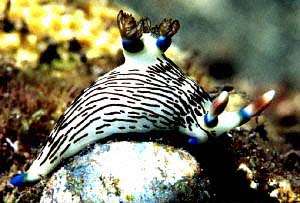
Here is Nembrotha lineolata (Bergh, 1905), Dauin, Negros Is., Philippines, Nov. 1998.
Erwin
E.Koehler@deutschepost.de
Koehler, E., 1999 (Jan 17) Nembrotha lineolata from Philippines. [Message in] Sea Slug Forum. Australian Museum, Sydney. Available from http://www.seaslugforum.net/find/479Nembrotha from SE Sulawesi
April 22, 1998
From: Lindsay Warren
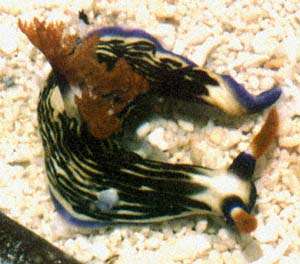
Dear Bill
Here is a Nembrotha for you. Unfortunately I have no details as to the exact nature of the surface on which they were found but they were also part of those found in the Tukang Besi Islands in SE Sulawesi last October. Looking forward to your comments on these. The opisthobranch species count for this area is now 70 and growing.
Many thanks for your help.
All the best
Lindsay Warren
100014.2112@compuserve.com
Warren, L., 1998 (Apr 22) Nembrotha from SE Sulawesi. [Message in] Sea Slug Forum. Australian Museum, Sydney. Available from http://www.seaslugforum.net/find/84This is another species? or colour form? in the Nembrotha lineolata colour group. We will need to have a much better idea of anatomy and colour variation within species before we can say whether we are dealing with one or a group of similarly coloured species. The animal in your photo has a remarkable resemblance to Hypselodoris maritima
Bill Rudman.
Nembrotha at Port Stephens
January 9, 1998
From: David & Leanne Atkinson
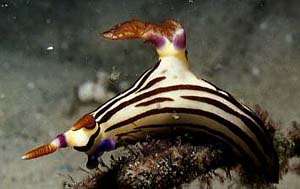
Bill,
We found these at Fly Point, Port Stephens, New South Wales over Christmas.
Thanks,
David & Leanne Atkinson.
atkin@hunterlink.net.au
Atkinson, D. & L., 1998 (Jan 9) Nembrotha at Port Stephens. [Message in] Sea Slug Forum. Australian Museum, Sydney. Available from http://www.seaslugforum.net/find/85This is a species of Nembrotha, but there is still no clear understanding about whether there is one species with a variable colour pattern or a number of species with a pattern of brown lines. Names in the group include Nembrotha purpureolineata O'Donoghue, 1924, Nembrotha rutilans Pruvot-Fol, 1931 and Nembrotha lineolata Bergh, 1905. ...Bill Rudman
Rudman, W.B., 1998 (Jan 9). Comment on Nembrotha at Port Stephens by David & Leanne Atkinson. [Message in] Sea Slug Forum. Australian Museum, Sydney. Available from http://www.seaslugforum.net/find/85